Quick question: If you were about to play a game of darts with a friend — and let’s just say for the sake of argument there’s some money riding on this — would you pause to put on a blindfold before throwing the first dart?
. . . I didn’t say it would be a good question.
But unfortunately, that’s exactly the way some companies run their inbound marketing campaigns: they target a broad audience in the hopes of hitting a few members of their target audience.
Fill a bucket with lots of darts.
Secure blindfold.
Throw!
Thankfully, this bad habit has a proven fix: buyer persona development.
What’s a Buyer Persona?
Simply put, your buyer persona is a fictional representation, or sketch, of your ideal customer, who is your target audience. It contains information relevant to a buying decision, such as their goals, pain points, major objections to buying your product or service, and more.
A thorough buyer persona helps you understand how and why your clients make decisions so that you can tailor your marketing efforts to their behaviors.
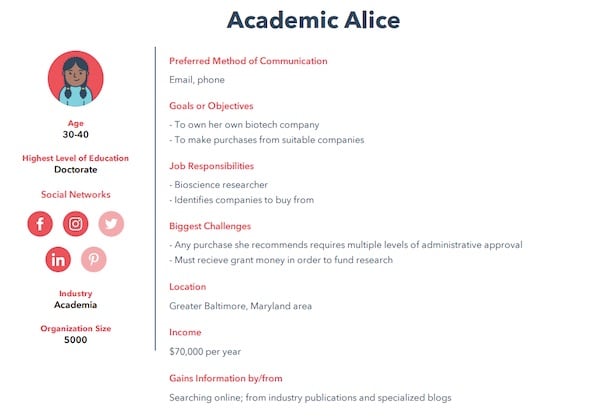
A buyer persona; Source: HubSpot
Why your company needs buyer personas
Knowing your specific buyer persona is so important to your integrated marketing campaign (and branding, and sales process development, etc.), that when our clients or prospective clients don’t have their buyer persona(s) clearly defined, we recommend that they pause all other aspects of their communications strategy and address the oversight.
The fact is, the fundamental elements of digital marketing - brand development, website design and development, content strategy, social media strategy, and SEO - are all inextricably linked to your buyer persona.
Having a clearly defined target audience allows you to write content your prospects are more likely to find compelling and useful, ads that are more narrowly targeted to reach them, and messaging that speaks to their situation. Without a clear idea of who they’re writing for, a company runs the risk of creating content and ads that appeal to no one in particular.
Understanding your audience inside and out can help you position yourself as an ally who can help solve their problems, which can lead to higher-quality leads and real impact on bottom-line revenue. In fact, 71% of companies who exceed their goals in both of these categories use buyer personas.
When the bottom line is king, your customers’ thoughts, problems, and aspirations should guide your company’s every move.
Developing Buyer Persona Profiles
First, put together a rough sketch of who your persona(s) might be, including information such as their industry, problems they face, their goals, and their objections to purchasing your products or services.
More than likely, you already have an idea which characteristics your best customers have in common. A successful buyer persona summarizes who your ideal audience is, offers insights into how they think, and identifies problems they are trying to solve through your product or service.
To develop your own buyer persona, ask your sales team some of the following questions about your customer base. Choose ones that are directly relevant to your business and customers' buying process.
Relevant data
- Where do they live? (Madison, WI)
- What is their experience level in their position? (Senior, 30 years of experience)
Motivations and factors that influence their buying decision
- What are their goals and aspirations? (want to increase production by 10x this quarter)
- What are their problems? (inefficient processes)
- What problems drive them to your business? (need help improving efficiency)
- What are their major objections, or “pain points,” to buying our product/service? (cost)
- How can we address those objections? (great ROI according to statistical data)
- What do they hope to accomplish by purchasing your products or services? (They will be able to solve problem “x”.)
- What concerns do they have? (job security, proving their contribution to the bottom line)
- What buyer’s journey (or sales funnel) stage are they in? (Awareness, Consideration, Decision)
- What are their main obstacles in making a purchase? (budget, approval)
- What level of authority does this person have in their organization? (decision maker, influencer)
- Who influences, or obstructs, their buying decision? (gatekeepers, administrative approval required)
It’s useful to think about your persona’s level of influence in the buying decision, and what people and factors influence that decision. As Katharine Derum points out, in the B2B world, leads tend to fall into one of four categories in their organization:
- Gatekeepers: assistants or associates of decision makers that can grant or block access to the decision maker
- Decision Makers: higher-level employees who make the ultimate purchasing decision, usually executives, directors, or managers
- Influencers: employees who can influence the buying decision, but do not have the power to make it themselves
- Blockers: employees who can influence the buying decision and block access to a decision-maker
Note whether your persona is an influencer, with less power and likely more obstacles in making a purchase, or a decision maker who has the power to make a purchase when they wish.
Consider the sorts of gatekeepers and blockers you might need to handle after you attract the attention of potential customers who match this persona.
Where they spend time online and content preferences
- What media do they rely on for information and answers to problems? (industry publications, specialized blogs, forums like Quora)
- What social media platforms do they visit regularly? (Facebook, LinkedIn)
- What types of content do they prefer? (white papers, case studies, blog posts)
- What tone do they respond to? (casual, professional, technical)
- How can we reach them? (email, telephone, text)
- What devices do they prefer to use? (mobile, desktop)
This data is extremely useful. Here’s why.
Where they get their information: helps you identify the style and tone of writing that your audiences prefer
Favorite social media platforms: helps you focus your advertising and social media content efforts on platforms where you’re guaranteed to reach your target audience
Favorite content types: helps you create content in forms your personas want to consume
Favorite style and tone: helps you address the audience in a way that pleases and engages them
Preferred methods of contact: how your audience prefers to be reached
Favorite devices: helps you create content that will look good and perform well on their favorite device
Check out this HubSpot template for a walk-through persona generator that helps you assemble all your buyer persona information into one profile.
It will ask you many questions like the ones above. If you want, you can customize your buyer persona to include the answers to questions it does not ask.
Write a brief bio for each buyer persona
To finish developing your buyer persona, create a short bio of your ideal customer in the first person (“I”). A short paragraph or two will do. Use the answers to the most important questions above: age, education, profession, content consumption habits, career goals, personal goals and interests, problems, and - it’s going to sound stupid - give them a name to help personalize them. For example:
Academic Alice
I am a biosciences researcher at a private university in Baltimore, MD. I’m 31 years old and married. My schedule is so packed that I do most of my product research online. My purchases require multiple levels of administrative approval. In addition, my research relies on grants which I must apply for annually.
One day, I want to found my own privately-held biotech company. For now, I make purchases for my university from companies I vet. I keep an eye on mainstream industry publications but prefer the less-formal tone of company blogs and citizen journalists in my niche. At home, I prefer my iPad to other devices.
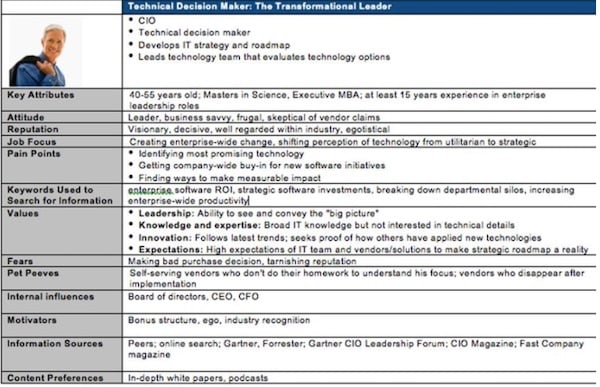 C-suite buyer persona; Source: Alexa
C-suite buyer persona; Source: Alexa
It’s common to have more than one persona. According to Mark Schaefer, “3 to 4 buyer personas usually account for 90% of a company’s sales.” As a result, it’s important to identify each one, and create content and messaging for every target audience.
How to perform market research for buyer persona development
If you want to create data-driven buyer personas, (especially if you plan to create content) consulting sales and analytics data and conducting market research can help you pinpoint who your customers are more precisely.
As part of your research, be intentional about gathering information around three things in particular:
- The voice and etiquette necessary to successfully engage your buyers
- Your buyers’ preferred engagement channels: favorite sites, favorite content types, communication habits
- The keywords and phrases you’ll need to harness for search engine optimization, since people often search with the same words and phrases they use in conversation.
Here are some tips for gathering this data:
- Ask your sales team about who your customers tend to be, what they want, the problems they face, common objections, and more
- Ask your customer service team what FAQs they receive
- Conduct surveys of existing customers
- Use BuzzSumo to see what social channels industry content is most frequently shared on, and the top shared content across those channels.
 Source: Google Search Console
Source: Google Search Console
- Use Google Search Console for free to see what keywords your website is appearing for in search results. To learn more about keyword research, check out this resource.
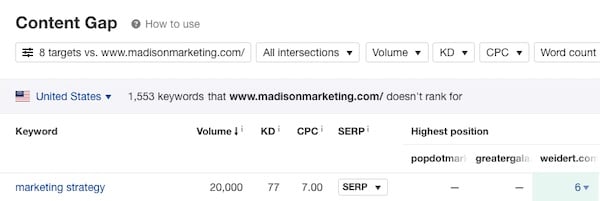
Source: Ahrefs
- Use a paid tool like Ahrefs or SEMrush to see what keywords your site is not appearing for, but your competitors are.
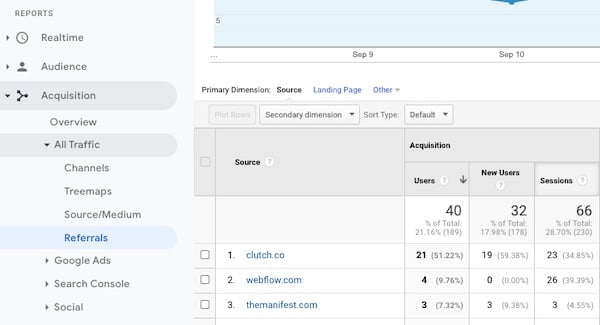 Referral report; Source: Google Analytics
Referral report; Source: Google Analytics
- Check out Google Analytics’ Acquisition reports, All Traffic>Referrals and All Traffic>Source/Medium in particular, to see which sites are driving traffic to your website. The traffic report shows how your site visitors found you, such as via search engines, ads, or social media posts.
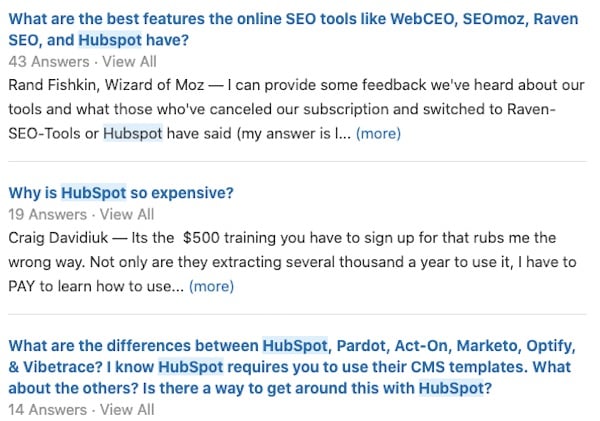 Hubspot threads; Source: Quora
Hubspot threads; Source: Quora
- Identify pain points (factors that will make or break a customer’s buying decision) by monitoring what people say about your brand online (on social media and forums, for example).
Conducting this type of research can help you refine your understanding of who your customers are, what they need, and what problems they face, based on hard data. If this is your first time conducting market research for personas, check out the resources below to get started.
Market research resources:
- ComScore (cross-platform market research)
- HubSpot’s “How to Do Market Research: A 6-Step Guide”
- HubSpot’s “How to Create Detailed Buyer Personas for Your Business [Free Persona Template]” (includes a great list of customer interview questions and a free buyer persona template)
Conclusion
If you’ve done your research and crafted an accurate buyer persona, you’ll have a ton of useful information for building the core elements of an inbound marketing plan (brand, web, content, social, search) tailored to each unique audience you want to target.
After the elements are in place, you’ll be able to focus on strategic communications guided by the most fundamental idea behind customer acquisition and retention: “They really do understand me.”
Putting together a digital marketing strategy? Check out our complete checklist.
Topics: Sales & Marketing Strategies, Strategic Blogging, Premium Content, Pillar Pages
Chris Murvine, CEO
Chris Murvine has worked in the digital marketing industry for over 20 years, developing expertise in technical-marketing strategies and growth-platform implementations. He founded Madison Marketing in 2008. Outside of the office, he enjoys spending time with family, camping, and riding all-terrain vehicles.





